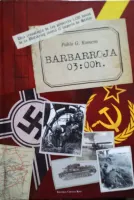[English version at the end]
PERSONAJES DE BARBARROJA
¡Ya a la venta Barbarroja 03:00 hrs!
TENIENTE GENERAL HERMANN HOTH (1885-1971)

El Generaloberst (teniente general) Hermann “Papa” Hoth es otra de las estrellas del arma acorazada (Panzerwaffe) de Alemania junto con clásicas figuras como Guderian, Kleist, Manstein, Höpner y otros. Labrará su fama como hombre directo, con cualidades para la estretegia y la táctica. Es bien apreciado por sus subordinados, quienes le tildan de «Papa».
Hoth participa en la Blitzkrieg contra Polonia al mando del XV. Armeekorps (mot.) (15º Cuerpo de Ejército Motorizado) y posteriormente en la campaña de Francia. Aquí, contra los aliados occidentales será premiado con la responsabilidad de dirigir un ejército completo (10. Armee).
Durante la ofensiva de Hitler contra la URSS, la Operación Barbarroja (Unternehmen Barbarossa), Hoth está mando del 3er Grupo Panzer (Grupo de Ejércitos Centro) y constituye el brazo norte de la pinza acorazada (Guderian conduce la sur) que atravesará velozmente Bielorrusia. Es la zona de responsabilidad del Distrito Especial Militar Occidental (transformado en «Frente Occidental») del general Dmitrii G. Pavlov. De él dependen 4 divisiones Panzer (7ª, 12, 19ª y 20ª) y otras 3 motorizadas (14ª, 18ª y 20ª) organizadas en dos cuerpos de ejército motorizados. Penetrará a través del territorio sin excesivas complicaciones y con ello sellará tres importantes cercos de tropas soviéticas en Bielostok, Novogrudok y este de Minsk. Mientras los Panzer no detienen su carrera hacia el este, se permite a la lenta infantería que progresa detrás que sellen las bolsas y las liquiden. Entra victorioso en Minsk en tan sólo 5 días tras el Barbarossatag (día de comienzo de la campaña). Junto con Guderian es fiel creyente de la guerra de movimiento. Otro defensor a ultranza de identificar el Schwerpunkt (punto ideal de ruptura) del dispositivo defensivo enemigo y atravesarlo. El apoyo aéreo esencial lo recibe del 2. Luftflotte (2ª Flota Aérea) del mariscal Albert Kesselring.

Una vez capturado Minsk en tiempo récord, procederá hacia el noreste (río Dvina occidental) y capturará Vitebsk el 10 de julio. Desde el norte, el 15 de julio cortará el cordón umbilical que une Smolensk con Moscú. Sus unidades Panzer de vanguardia interceptan las vías férreas y la autopista que une las dos urbes. Entonces se enfrentará a una violenta reacción soviética y actuará de pantalla mientras Guderian desde el sur entra en Smolensk. Tras la toma y fintar el contragolpe soviético, tanto sus fuerzas como las de Guderian necesitarán un parón operativo de varias semanas antes de proseguir. Para sorpresa de todos y mentalizado a continuar hacia Moscú, del OKW (Oberkommando der Wehrmacht – Alto Mando de las Fuerzas Armadas) llegarán órdenes muy diferentes…
¿Te ha resultado de interés este artículo? Deja tu comentario abajo…
¡Adquiere la obra cronológica Barbarroja 03:00h en edición de coleccionista!
Sigue interesantes referencias también en Twitter @barbarroja0300h
[English version]
BARBAROSSA’S PROTAGONISTS
COLONEL-GENERAL HERMANN HOTH (1885-1971)

Colonel-General Hermann “Papa” Hoth is one another of Germany’s Armoured Arm (Panzerwaffe) «stars» along with men like Guderian, Kleist, Manstein, Höpner, etc…He enjoys a reputation of steady man, skilled for the strategy and the tactics. His men respect him and nickname him «Papa».
Hoth takes part in the Polish Blitzkrieg in command of the XV. Armeekorps (mot.) (15th Motorized Army Corps) and later on in the French campaign. This time, against the Western allies he will be prized with a higher resposibility leading a full army (10. Armee).
During Hitler’s offensive against the USSR, Operation Barbarossa (Unternehmen Barbarossa), Hoth is in command of the 3rd Panzer Group (Army Group Centre) and becomes the northern pincer (Guderian manages de southern one) that races throughout Belarus. This is the area of resposibility of the Soviet Western Special Military District (becoming the «Western Front» or Zapadnyi Front) under General Dmitrii G. Pavlov. In the order of battle he 0s given 4 Panzer (7th, 12th, 19th and 20th) plus 3 motorized divisions (14th, 18th and 20th). He will go across the Soviet defenses init
ially without major operational difficulties and manages to lock up vast number of enemy troops in three consecutive “cauldrons” in Bielostok, Novogrudok and Eastern Minsk. Along with Guderian he is a faithful follower of the mobile warfare doctrine. He defends the idea of identifying the Schwerpunkt (ideal point of rupture) of the enemy’s defenses and break through it. His air support will come from the hands of Field Marshall Albert Kesselring‘s 2. Luftflotte (2nd Air Fleet).

Once Minsk falls in record time, he will lead his Panzer force due northeast (towards the Western Dvina river) and will seize Vitebsk. At that stage he will face a serious Soviet counterattack and will fight it off like a shield, while Guderian captures Smolensk (on the highway to Moscow). After the fall of the historical city of Smolensk and resisting the enemy’s counterstroke, Hoth and Guderian will need to make an operational halt of some weeks to rest and refit, before retaking the offensive. To everyone’s surprise and when he is convinced Moscow comes next, the OKW (Oberkommando der Wehrmacht – Armed Forces High Command) will issue very different orders…
Did you find this article interesting? Leave your comments below…
Follow other articles in Twitter @barbarroja0300h



11 respuestas a “HOTH, Hermann. Generaloberst.”